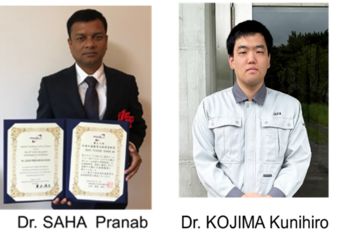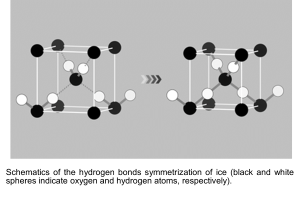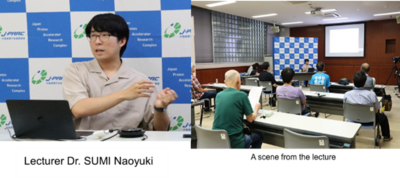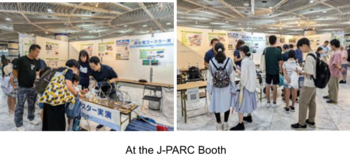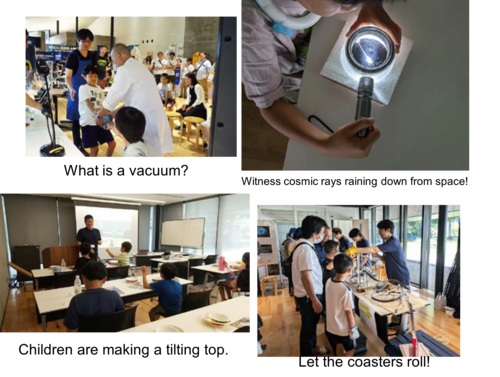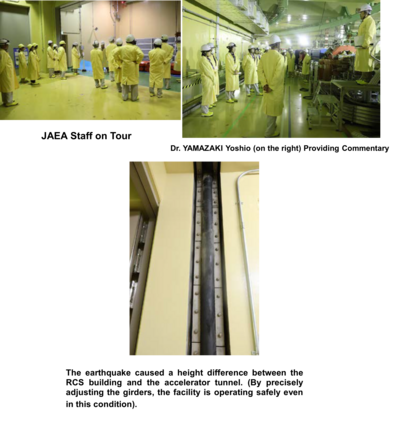J-PARC News August 2024 (Issue #232)
■Received two awards from the Particle Accelerator Society of Japan ( July 31st- August 3rd )
The following two awards were presented at this conference , which was held in Yamagata City from July 31st to August 3rd .
(1) Technical Contribution Award
Dr. SAHA Pranab of the Accelerator Section Ⅲ received the award. The award is given for outstanding technical contributions to the construction, operation, and use of accelerators, and to the development of manufacturing technology.
Through numerical simulations and tests with real beams, he has studied the minimization of beam loss in the RCS, one of the accelerators at J-PARC. The results of this study will be essential for the stable operation of the RCS at 1 MW and for the realization of the beam intensity in the Main Ring in the future.
(2) Annual Meeting Award
Dr. KOJIMA Kunihiro of the Accelerator Section Ⅲ received the award. This award is intended to encourage students and young researchers in the early stages of their research activities and careers and is given for outstanding presentations at annual meetings of the society.
From the research on beam loss reduction in RCS, he was commended for finding conditions that minimize beam loss during high intensity beam operation.
■What happens when water is compressed to the extreme?
- Hydrogen bond symmetrization in ice has been successfully observed in high-pressure neutron diffraction experiments! - (June 27th)
It has long been known that compression of ice causes a "symmetrization of hydrogen bonds", in which a hydrogen atom between adjacent oxygen atoms moves toward the center under very high pressure. This can be directly observed by neutron diffraction but has been experimentally difficult due to the limited pressure range currently available. Verification of the hydrogen bond symmertization was one of the most attractive targets in high-pressure neutron science.
Using a diamond anvil high-pressure cell equipped with “nano-polycrystalline diamonds” which is harder than natural diamond, the research team developed a neutron diffraction method above 100 GPa (a million atmospheric pressure) and conducted high-pressure experiments up to 100 GPa at the high-pressure PLANET beamline at J-PARC. Finally, they finally succeed in observing hydrogen-bond symmetrization at 80 GPa for the first time in the world. This result is useful not only for understanding the physicochemical properties of ice, but also for estimating the state of ice in the deep interior of the Earth and in space.
■The proposal and demonstration of a new mechanism of ferroelectricity induced by the coupling of chirality and axial vector
- Expectation of the development acceleration of a new type of ferroelectric material with magnetism and electrical conductivity -
Ferroelectricity with magnetism and electric conductivity is an exotic physical property, which is leading to development of a new type of functional device.
The research group proposed a new type of ferroelectric mechanism caused by the coupling of chirality and axial vector by reconsidering of ferroelectricity from the perspective of the crystal structural symmetry.
In fact, it was revealed that the phase transition together with the changes of the rotation angle of the helical chain on magnetic materials SrM2V2O8(M = Ni, Mg, Co) by neutron powder diffraction measurement at BL08, SuperHRPD, installed MLF, J-PARC. That result demonstrated the proposed ferroelectric mechanism.
This achievement opens the possibility that materials with compositions and crystal structures previously overlooked could become ferroelectric. This is expected to accelerate the development of not only magnetic ferroelectrics, but also unconventional ferroelectric materials with electrical conductivity.
■Superconducting magnets working around detectors (July 26th)
Dr. SUMI Naoyuki of Cryogenics Section introduced the principles and features of superconducting magnets used in various research facilities at J-PARC.
Superconductivity, in which electrical resistance is reduced to zero when cooled to extremely low temperatures, can be used to create powerful electromagnets.
Although superconducting magnets may have a strong image of being "used in accelerators" by bending particles in a strong magnetic field, they are active in various parts of experiments at J-PARC, supporting research.
For example, in a neutron lifetime measurement experiment, a strong magnetic field can be used to separate the background event from the beta decay signal, allowing more accurate measurements.
In addition, the COMET experiment uses three giant superconducting magnets with different applications to focus the beam, select the particles of interest, and detect the signal to search phenomena that occur only once in 100 trillion times.
■Exhibited at Eco-Fest Hitachi 2024 (July 20th, Hitachi Civic Center, etc.)
On the first day of summer vacation for many children, "Eco-Fest Hitachi 2024," an environmental event where they can learn through experimentation and hands-on experience, was held at Hitachi Civic Center and other venues.
At the J-PARC Center booth, we demonstrated a superconducting coaster and introduced J-PARC. The superconducting coaster, in which a superconductor cooled to nearly -200°C slides along the rails like a roller coaster while levitating, was very well attended by both children and adults.
In addition, a model of J-PARC and some posters of J-PARC were also on display, highlighting J-PARC's contributions to improving fuel cell performance and more.
■Children's Kasumigaseki Open Day "Let's make a kaleidoscope of light" (August 7th and 8th)
The Children's Kasumigaseki Open Day is an initiative that aims to provide children with an opportunity to learn about society and deepen parent-child interaction through explanations of the operations of various government ministries and agencies and workplace tours.
This year, 28 government ministries and agencies implemented the program. At the Japan Atomic Energy Agency (JAEA) booth at the Ministry of Education, Culture, Sports, Science and Technology (MEXT), children learned that light is a wave and has three primary colors by making a kaleidoscope of light. The J-PARC Center was also introduced.
The children pointed the sheet of the spectrometer at various light sources and observed the differences in the appearance of rainbow-colored light while cheering. It must have been a memorable summer vacation experience.
■Science x Tokai-Village x J-PARC Exhibition” is now open. (July 20th-September 29th, Tokai Village Museum)
In workshops called "Tokai Science Lab," J-PARC researchers conducted experiments and crafts with participants.
You can enjoy the special exhibition entitled "Our world is made up of particles," a riddle-solving mission, and special exhibits that bring you closer to the true self of scientists through September 29th. Please visit Tokai Village Museum.
■Invitation to J-PARC Open House 2024 (September 28th)
J-PARC Open House 2024 will be held on Saturday, September 28th, and will feature many events, including tours of large experimental facilities and accelerators (some of which require reservations), a science cafe, hands-on corners, experimental craft workshops, a stamp collecting rally, and more. There will also be food trucks, J-PARC merchandise for sale, and more. We hope you will join us.
Visit the website for more information on how to get to the event.
https://j-parc.jp/OPEN_HOUSE/2024/img/J-PARC_OPEN-HOUSE2024es.pdf#zoom=100
■Invitation to the J-PARC Public Lecture (October 14th)
The J-PARC Center will host a J-PARC Symposium October 14th-18th to celebrate the facility's 15th anniversary. In conjunction with the symposium, a public lecture entitled "The Future J-PARC Creates, the Mysteries J-PARC Explores - From Next-Generation Energy to the Universe" will be held on October 14th (Monday, holiday) at the Mito-City Civic Hall. We look forward to seeing you there. Please visit the J-PARC Public Lecture special page: https://www.j-parc.jp/symposium/j-parc2024/
■J-PARC Sanpo-michi ㊾ J-PARC Facility Study Session Held by Construction Engineering Department
The Great East Japan Earthquake of March 11th, 2011, caused extensive damage, including flooding in the accelerator tunnels, but operations resumed by Christmas of that year. The speed of the recovery was praised as amazing by the accelerator community around the world.
The Japan Atomic Energy Agency (JAEA) and the High Energy Accelerator Research Organization (KEK), to which J-PARC belongs, have various world-class facilities. The Construction and Engineering Department Liaison Meeting is held annually to closely exchange information and share expertise through technical visits related to the construction and engineering of these facilities.
As part of this liaison meeting, staff from the construction and engineering sections working for JAEA visited the J-PARC facilities on July 26th. They entered the Linac and RCS accelerator tunnels and the roof of the Materials and Life Science Experimental Facility to discuss technical issues related to the aging of the building, which is about 20 years old since its construction. In addition to the characteristics of the J-PARC buildings and facilities, the restoration procedures were explained in detail.

